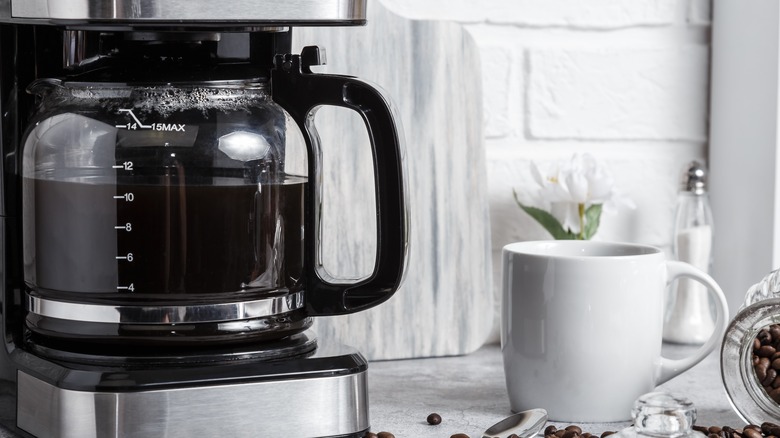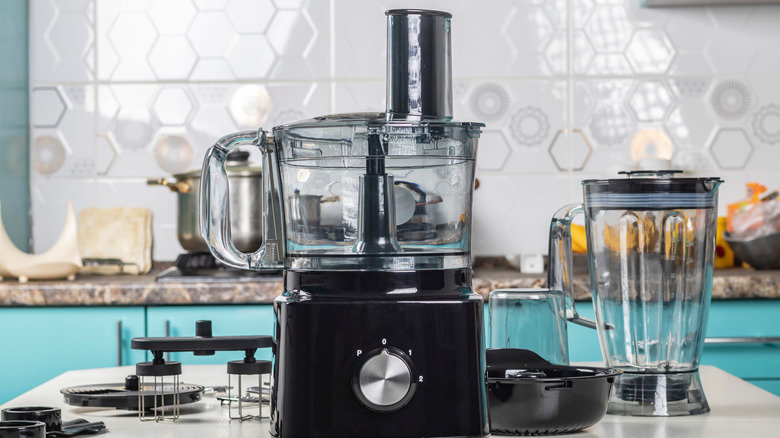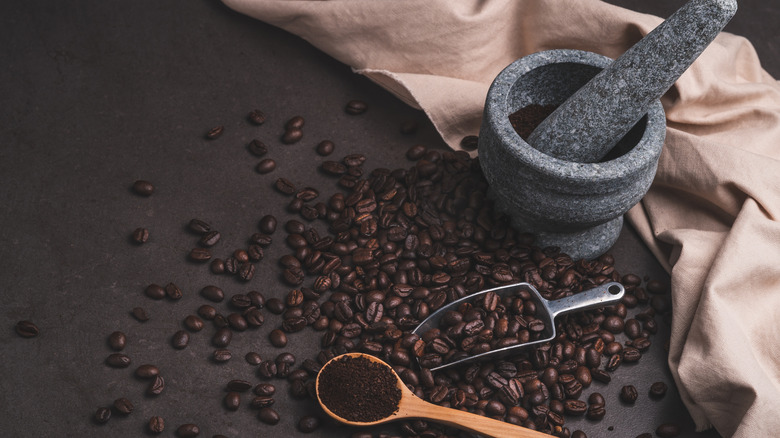The Easiest Way To Grind Coffee Beans Without A Grinder On Hand
Coffee — it's a way of life. Whether your drink of choice is a steaming latte, iced Americano, or even a decaf cup of joe, for many of us, it's a requirement. If you're being economical and making your coffee at home, the essential first step is, of course, the beans. If you've ever bought a bag of whole beans only to realize it's 8 a.m. and you don't have a coffee grinder on hand, don't panic. There are quite a few options for how to grind coffee beans if you don't have access to an industrial-strength grinder at the grocery store or a fancy burr grinder at home.
Of course, a coffee grinder is always the best route. It's specifically designed to evenly and consistently grind whole beans into a uniform size. And uniformity is key for the perfect cup of coffee, as it turns out. If you have a hodgepodge of different-sized grinds, you may not notice, but your tastebuds will, as inconsistently sized grounds impact the steeping and brewing process as well as the way water interacts with the grounds. If you're in a pinch, you have options here — a regular old blender, food processor, or even an old-school mortar and pestle will get the job done.
A food processor is your best bet for grinding coffee beans if you don't have a grinder
Most of us have a food processor in our kitchen for grinding up garlic or nuts or making pesto, but you can also use it to grind coffee beans. It may just be the closest dupe to an actual grinder — using a food processor provides ample space for the beans and creates consistent, evenly sized grounds.
Because of its size, a food processor can typically handle a larger quantity of beans at once than other options. Use the grind setting, if yours comes with one. You want to stick to grinding your beans in small quantities. Go about ¼ cup at a time, transferring the grounds into whatever container you plan to store them in before loading up the food processor and grinding your next batch.
If you're about to grind coffee beans without a grinder (or even when using a grinder!) be mindful of the temperature. The heat generated by those whirring blades can easily melt the bean's oils and burn delicate beans, ruining that perfect pour. Instead, use short pulses or bursts to avoid overheating and turning the beans bitter. It's worth noting that a blender will also work similarly if you don't have a food processor.
How to grind coffee beans the low tech way
Don't have a processor or blender handy or just want to grind your coffee without a grinder, old-school style? Whether you're channeling your inner pioneer, out of power, or just low on options, a manual mortar and pestle can be a great option for pulverizing beans. That's right, the same tool that's been used since early civilization to crush everything from spices to pharmaceuticals can also grind coffee beans surprisingly effectively. Just place whole beans in and crush them using a downward twisting motion. Similar to a food processor, it also pays to fill your mortar with a smaller amount versus trying to tackle all your beans at once. This makes the beans you're working with easier to control, so they don't go flying everywhere. Using a mortar and pestle also allows you to completely control the size of your grounds and visually inspect them for the best possible uniformity.
Ultimately, the method you're using to brew determines the size of the ground you're looking for. Too large or too small a grind can impact the taste and ultimately leave you with a bad-tasting cup. As a rule of thumb, if you're making your java with a French press, you'll want a larger, coarser grind. For a pour-over cup, go for a medium grind, while a finer, smaller ground is what you need for espresso. However you make yours, here's to the best part of waking up.


